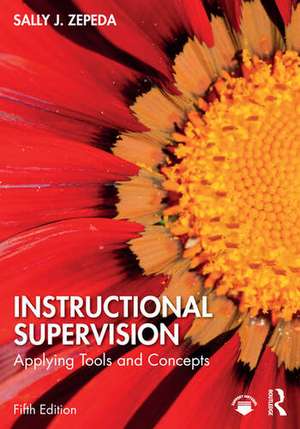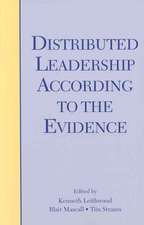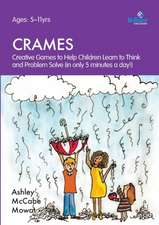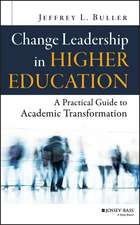Instructional Supervision
Autor Sally J. Zepedaen Limba Engleză Paperback – 3 iun 2025
| Toate formatele și edițiile | Preț | Express |
|---|---|---|
| Paperback (1) | 564.96 lei 6-8 săpt. | |
| Taylor & Francis – sep 2016 | 564.96 lei 6-8 săpt. | |
| Hardback (1) | 1123.37 lei 6-8 săpt. | |
| Taylor & Francis – 17 noi 2016 | 1123.37 lei 6-8 săpt. |
Preț: 490.54 lei
Preț vechi: 533.19 lei
-8% Nou
Puncte Express: 736
Preț estimativ în valută:
93.87€ • 100.37$ • 78.26£
93.87€ • 100.37$ • 78.26£
Carte nepublicată încă
Doresc să fiu notificat când acest titlu va fi disponibil:
Se trimite...
Preluare comenzi: 021 569.72.76
Specificații
ISBN-13: 9781032638003
ISBN-10: 1032638001
Pagini: 434
Dimensiuni: 178 x 254 mm
Ediția:5. Auflage
Editura: Taylor & Francis Ltd.
ISBN-10: 1032638001
Pagini: 434
Dimensiuni: 178 x 254 mm
Ediția:5. Auflage
Editura: Taylor & Francis Ltd.
Cuprins
Supplemental Downloads
About the Author
Acknowledgments
Introduction
1 Leadership Needed to Promote Supervision, Professional Development, and Teacher
Evaluation That Makes a Difference
Introduction
Supervision, Professional Development, and Teacher Evaluation Are Not Linear, Lockstep
Processes
Leadership Beliefs and Practices to Unify Processes
Coherence Needed for Instructional Supervision, Professional Development, and Teacher
Evaluation
Accountability and High Stakes Challenges for Supervisors
Tool 1: Developing a Unified Vision for Supervision, Professional Development, and
Teacher Evaluation
Summary
Suggested Activities
References
2 Instructional Supervision
Introducing Instructional Supervision
The Intents of Instructional Supervision
Differentiated Supervision
Developmental Supervision
Styles That Support Differentiated and Developmental Supervision
Summary
Suggested Activities
References
3 Teacher Evaluation
Introducing Teacher Evaluation
The Intents and Purposes of Teacher Evaluation
Formative and Summative Evaluation
Federal and State Influences on Teacher Evaluation
Teacher Evaluation Systems
Value-Added Measures
Summary
Suggested Activities
References
4 Job-Embedded Professional Development
Introducing Job-Embedded Professional Development
Status of Professional Development
Standards for Professional Development
Learning Communities—More than a Reform Strategy
Tool 2: Job-Embedded Learning: Finding Time for Professional Development
Tool 3: Planning for Professional Development
Tool 4: Identifying Professional Development Needs
Making the Connection Between Instructional Supervision, Professional Development, and Job-Embedded Learning
Summary
Suggested Activities
References
5 Instruction and Learning Environments
Introducing Instruction and Learning Environments
Teacher Quality and Teacher Effectiveness
Effective Teachers
Accountability and Standards
Effective Instructional Practices
Inside Teacher Evaluation Frameworks
Observable Practices
Tool 5: Contextualizing Teaching and Learning—Getting to Observable Practices
Personalized Learning Environments and Learning Technologies
Summary
Suggested Activities
References
6 Career Stages, Adult Learning, and Supervision
Introducing Career Stages, Adult Learning, and Supervision
Tool 6: Career Stages
Tool 7: Goal Setting, Tracking Faculty Goals, and Goal Attributes
Adult Learning
Supervision That Embraces the Adult Learner across Career Stages
Summary
Suggested Activities
References
7 Motivation and Supervisory Leadership
Introducing Motivation and Supervisory Leadership
Motivation Defined
Motivation Theories
Leadership and Motivation
Implications for Supervisors
Summary
Suggested Activities
References
8 Informal and Formal Classroom Observations
Introducing Informal and Formal Classroom Observations
Group Classroom Observations
Tool 8: Informal Classroom Observations
Tool 9: Guidelines for Informal Classroom Observations
Formal Classroom Observations
The Clinical Supervision Model and Its Components
Summary
Suggested Activities
References
9 The Pre-observation Conference
Introducing the Pre-observation Conference
Tool 10: Attributes of the Pre-observation Conference
Focus and the Pre-observation Conference
The Johari Window and the Pre-observation Conference
How to Prepare for the Classroom Observation
Summary
Suggested Activities
References
10 The Classroom Observation
Introducing the Classroom Observation
The Intents of Data Collection
Tool 11: Types of Data
Tool 12: Wide-Angle and Narrow-Angle Data Collection Techniques
Tips from the Field
Overview and Application of Observation Tools and Methods
Tool 13: Observation Guide Using Bloom’s Taxonomy
Tool 14: Focus on Wait Time
Tool 15: Focus on Cause-and-Effect Data
Tool 16: Focus on Variety of Instructional Methods
Tool 17: Examining Teacher–Student Discussion with a Focus on How Student Comments Are Incorporated into the Lesson
Tool 18: Selective Verbatim: Teacher’s Verbal and Students’ Physical and Verbal Behaviors
Tool 19: Wide Angle: No Focus
Tool 20: Focus on Calling Patterns and Patterns of Interaction
Tool 21: Focus on Tracking Transition Patterns
Tool 22: Tracking the Beginning and Ending (Closure) of Class
Tool 23: Observing Cooperative Group Learning
Tool 24: Classroom Traffic
Summary
Suggested Activities
References
11 The Post-observation Conference
Introducing the Post-observation Conference
The Purposes of the Post-observation Conference
Lesson Reconstruction, Constructivism, and the Zone of Proximal Development
Preparing for the Post-observation Conference
Supervisory Approaches and the Post-observation Conference
Tool 25: Feedback, Trust, and the Johari Window Revisited
After the Post-Observation Conference, Then What?
Tool 26: Planning for Professional Growth
Summary
Suggested Activities
References
12 Mentoring and Induction
Introducing Mentoring and Induction
The Multifaceted and Complex Nature of Mentoring
Examining Qualities, Skills, and Functions of Mentors
Selecting, Training, and Assigning Mentors
Induction: Where Mentoring Matters Most
Formative Assistance: The Linkage to Supervision
Summary
Suggested Activities
References
13 Peer Coaching
Introducing Peer Coaching
Frame Peer Coaching
Phases of the Original Peer Coaching Model
Types of Coaching
Peer Coaching Includes Classroom Observations
Conditions for Successful Peer Coaching
Connecting Peer Coaching to Other Forms of Supervision
Summary
Suggested Activities
References
14 Action Research
Introducing Action Research
Action Research Defined
Models of Action Research
The Processes and Components of Action Research
Reflection
Connecting Action Research to Instructional Supervision
Summary
Suggested Activities
References
15 Portfolio Supervision
Introducing Portfolio Supervision
What is a Portfolio?
Extending Clinical Supervision through Portfolio Development
A Model of Portfolio Supervision
Essential Skills: Reflection, Goal Setting, and Decision Making
The Portfolio as a Framework to Extend Supervision
Summary
Suggested Activities
References
16 Confronting Marginal Teaching
Introducing Confronting Marginal Teaching
Marginal Teaching
Markers of Marginal Teacher Performance
Understanding the Difficulties Supervisors Encounter While Working with Marginal Teachers
Confronting Marginal Teaching Practices
Working with Marginal Teachers
Tool 27: Formal Plan of Remediation
When All Else Fails
Summary
Suggested Activities
References
17 Coda for Instructional Supervision
References
Appendix: Classroom Observation Tools
Index
About the Author
Acknowledgments
Introduction
1 Leadership Needed to Promote Supervision, Professional Development, and Teacher
Evaluation That Makes a Difference
Introduction
Supervision, Professional Development, and Teacher Evaluation Are Not Linear, Lockstep
Processes
Leadership Beliefs and Practices to Unify Processes
Coherence Needed for Instructional Supervision, Professional Development, and Teacher
Evaluation
Accountability and High Stakes Challenges for Supervisors
Tool 1: Developing a Unified Vision for Supervision, Professional Development, and
Teacher Evaluation
Summary
Suggested Activities
References
2 Instructional Supervision
Introducing Instructional Supervision
The Intents of Instructional Supervision
Differentiated Supervision
Developmental Supervision
Styles That Support Differentiated and Developmental Supervision
Summary
Suggested Activities
References
3 Teacher Evaluation
Introducing Teacher Evaluation
The Intents and Purposes of Teacher Evaluation
Formative and Summative Evaluation
Federal and State Influences on Teacher Evaluation
Teacher Evaluation Systems
Value-Added Measures
Summary
Suggested Activities
References
4 Job-Embedded Professional Development
Introducing Job-Embedded Professional Development
Status of Professional Development
Standards for Professional Development
Learning Communities—More than a Reform Strategy
Tool 2: Job-Embedded Learning: Finding Time for Professional Development
Tool 3: Planning for Professional Development
Tool 4: Identifying Professional Development Needs
Making the Connection Between Instructional Supervision, Professional Development, and Job-Embedded Learning
Summary
Suggested Activities
References
5 Instruction and Learning Environments
Introducing Instruction and Learning Environments
Teacher Quality and Teacher Effectiveness
Effective Teachers
Accountability and Standards
Effective Instructional Practices
Inside Teacher Evaluation Frameworks
Observable Practices
Tool 5: Contextualizing Teaching and Learning—Getting to Observable Practices
Personalized Learning Environments and Learning Technologies
Summary
Suggested Activities
References
6 Career Stages, Adult Learning, and Supervision
Introducing Career Stages, Adult Learning, and Supervision
Tool 6: Career Stages
Tool 7: Goal Setting, Tracking Faculty Goals, and Goal Attributes
Adult Learning
Supervision That Embraces the Adult Learner across Career Stages
Summary
Suggested Activities
References
7 Motivation and Supervisory Leadership
Introducing Motivation and Supervisory Leadership
Motivation Defined
Motivation Theories
Leadership and Motivation
Implications for Supervisors
Summary
Suggested Activities
References
8 Informal and Formal Classroom Observations
Introducing Informal and Formal Classroom Observations
Group Classroom Observations
Tool 8: Informal Classroom Observations
Tool 9: Guidelines for Informal Classroom Observations
Formal Classroom Observations
The Clinical Supervision Model and Its Components
Summary
Suggested Activities
References
9 The Pre-observation Conference
Introducing the Pre-observation Conference
Tool 10: Attributes of the Pre-observation Conference
Focus and the Pre-observation Conference
The Johari Window and the Pre-observation Conference
How to Prepare for the Classroom Observation
Summary
Suggested Activities
References
10 The Classroom Observation
Introducing the Classroom Observation
The Intents of Data Collection
Tool 11: Types of Data
Tool 12: Wide-Angle and Narrow-Angle Data Collection Techniques
Tips from the Field
Overview and Application of Observation Tools and Methods
Tool 13: Observation Guide Using Bloom’s Taxonomy
Tool 14: Focus on Wait Time
Tool 15: Focus on Cause-and-Effect Data
Tool 16: Focus on Variety of Instructional Methods
Tool 17: Examining Teacher–Student Discussion with a Focus on How Student Comments Are Incorporated into the Lesson
Tool 18: Selective Verbatim: Teacher’s Verbal and Students’ Physical and Verbal Behaviors
Tool 19: Wide Angle: No Focus
Tool 20: Focus on Calling Patterns and Patterns of Interaction
Tool 21: Focus on Tracking Transition Patterns
Tool 22: Tracking the Beginning and Ending (Closure) of Class
Tool 23: Observing Cooperative Group Learning
Tool 24: Classroom Traffic
Summary
Suggested Activities
References
11 The Post-observation Conference
Introducing the Post-observation Conference
The Purposes of the Post-observation Conference
Lesson Reconstruction, Constructivism, and the Zone of Proximal Development
Preparing for the Post-observation Conference
Supervisory Approaches and the Post-observation Conference
Tool 25: Feedback, Trust, and the Johari Window Revisited
After the Post-Observation Conference, Then What?
Tool 26: Planning for Professional Growth
Summary
Suggested Activities
References
12 Mentoring and Induction
Introducing Mentoring and Induction
The Multifaceted and Complex Nature of Mentoring
Examining Qualities, Skills, and Functions of Mentors
Selecting, Training, and Assigning Mentors
Induction: Where Mentoring Matters Most
Formative Assistance: The Linkage to Supervision
Summary
Suggested Activities
References
13 Peer Coaching
Introducing Peer Coaching
Frame Peer Coaching
Phases of the Original Peer Coaching Model
Types of Coaching
Peer Coaching Includes Classroom Observations
Conditions for Successful Peer Coaching
Connecting Peer Coaching to Other Forms of Supervision
Summary
Suggested Activities
References
14 Action Research
Introducing Action Research
Action Research Defined
Models of Action Research
The Processes and Components of Action Research
Reflection
Connecting Action Research to Instructional Supervision
Summary
Suggested Activities
References
15 Portfolio Supervision
Introducing Portfolio Supervision
What is a Portfolio?
Extending Clinical Supervision through Portfolio Development
A Model of Portfolio Supervision
Essential Skills: Reflection, Goal Setting, and Decision Making
The Portfolio as a Framework to Extend Supervision
Summary
Suggested Activities
References
16 Confronting Marginal Teaching
Introducing Confronting Marginal Teaching
Marginal Teaching
Markers of Marginal Teacher Performance
Understanding the Difficulties Supervisors Encounter While Working with Marginal Teachers
Confronting Marginal Teaching Practices
Working with Marginal Teachers
Tool 27: Formal Plan of Remediation
When All Else Fails
Summary
Suggested Activities
References
17 Coda for Instructional Supervision
References
Appendix: Classroom Observation Tools
Index
Notă biografică
Sally J. Zepeda is Professor of Educational Administration and Policy at the University of Georgia, USA.
Recenzii
This 4th edition provides a masterful blending of time-tested supervisory tools with the latest trends in evaluation including value-adding measures, the influence of current legislation such as the Every Student Succeeds Act, and the continuing impact of technology in learning and teacher evaluation. Dr. Zepeda has provided a valuable resource from both a theoretical and practical perspective.
- R. Stewart Mayers, Professor of Educational Instruction and Leadership, Southeastern Oklahoma State University
"I consider this text the quintessential resource in developing aspiring school leader’s knowledge and skills as they work to improve teacher practice. This 4th edition is additive in its organization of chapters and of current issues surrounding teacher evaluation, teacher learning communities, and effective teaching."
- Dana Bickmore, Associate Professor, School of Environmental and Public Affairs, University of Nevada, Las Vegas
"The new edition of this popular supervision text is focused on bringing much-needed coherence to the field. Dr. Zepeda presents a unified vision for supervision, professional development, and teacher evaluation centered on teacher growth and development."
- Stephen P. Gordon, Professor of Education and Community Leadership, Texas State University
- R. Stewart Mayers, Professor of Educational Instruction and Leadership, Southeastern Oklahoma State University
"I consider this text the quintessential resource in developing aspiring school leader’s knowledge and skills as they work to improve teacher practice. This 4th edition is additive in its organization of chapters and of current issues surrounding teacher evaluation, teacher learning communities, and effective teaching."
- Dana Bickmore, Associate Professor, School of Environmental and Public Affairs, University of Nevada, Las Vegas
"The new edition of this popular supervision text is focused on bringing much-needed coherence to the field. Dr. Zepeda presents a unified vision for supervision, professional development, and teacher evaluation centered on teacher growth and development."
- Stephen P. Gordon, Professor of Education and Community Leadership, Texas State University














